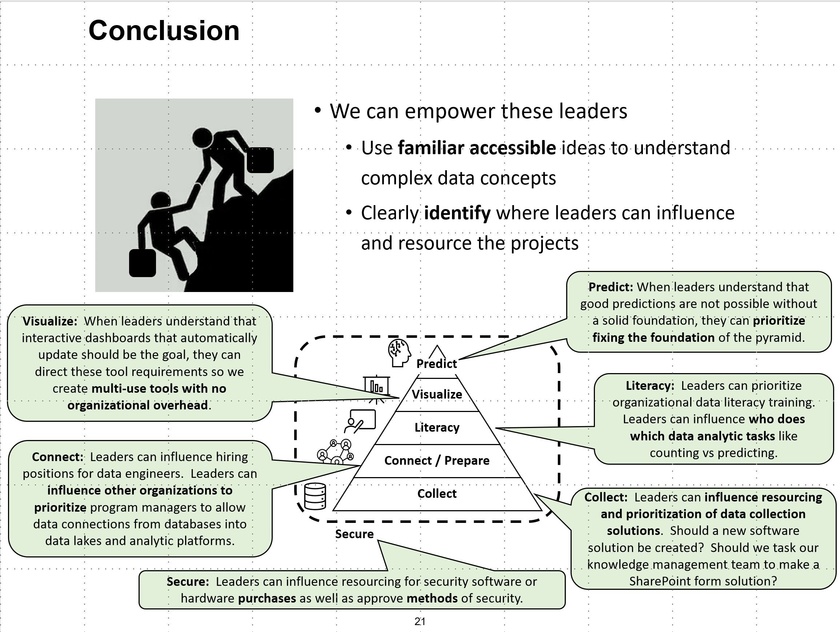This week’s article delves into the critical intersection of decision-making processes in business and the integration of data analysis to enhance the quality and effectiveness of a leader’s decisions. By examining a decision-making framework and exploring the pivotal role of data analysis within this context, this article aims to provide leaders with insights into leveraging data to inform knowledgeable and intuitive decision-making. It also explores issues related to data quality, the need for advanced analytics skills, and the ethical implications of data usage. This week debuts the partnership with Folk Media Studio to develop our interview series on “Leaders and Supporters.” For this topic, we interview Lieutenant Colonel (LTC) Melissa Sayers, a professional data scientist for the U.S. Army, to discuss how she incorporates data analysis to support her leaders' decision-making process.
LTC Melissa Sayers is currently serving as an Operations Research Systems Analyst (ORSA) in the United States Army at First Army, Rock Island Arsenal, Illinois. Melissa has nine years of experience using data to solve business problems and communicate with operational leaders. She builds data engineering pipelines, teaches data literacy, and leverages optimization and prediction to enable decisions. Her recent experience focuses on transportation tracking, efficient business operations, financial auditability, and recruiting challenge identification. She routinely codes in Python (Spark, pandas), R (tidyverse, RStudio), and SQL using tools like Foundry, DataBricks, Amazon Web Services ec2 instances, PowerBI, and Tableau. Melissa holds a Master of Computer Science in Data Science from the University of Illinois at Urbana/Champaign. She also holds a Bachelors in Physics and a Bachelors in Mechanical Engineering. She is a member of the Military Operations Research Society where she is a co-chair and co-founder of the Analytic Capability Development working group focused on manning, training, and equipping data-focused professionals.
LTC Sayers discusses her techniques for supporting her leaders with decision-making. Below is a sample of what we discussed. To see the full version and more on this topic, become a paid subscriber.
The sources for this article:
Chen, H., Chiang, R. H., & Storey, V. C. (2012). Business intelligence and analytics: From big data to big impact. MIS Quarterly, 36(4), 1165–1188.
LaValle, S., Hopkins, M. S., Lesser, E., Shockley, R., & Kruschwitz, N. (2010). Analytics: The new path to value. MIT Sloan Management Review, 52(1), 1–8.
Wu, J., & Du, S. (2017). A conceptual framework for understanding the application of big data in the hotel industry. International Journal of Contemporary Hospitality Management, 29(12), 3085–3103.
Week 5: “Data-Driven Decision-Making Skills.” Leaders and Supporters Series, Folk Media Studio, 31 January 2024, https://thedavarkgroup.substack.com/.
In the dynamic landscape of business, effective decision-making is a cornerstone of organizational success. First, we want to discuss a good decision-making process that not only incorporates successful methodologies but also places a significant emphasis on the integration of data analysis. By grounding decisions in data-driven insights, leaders can navigate uncertainties with greater precision, agility, and speed.
Decision-Making Framework
Stage 1: Identify the Mission or Problem.
Your organization will have a more efficient time developing the future state when they have systems or processes in place to see a problem before it is detrimental. It also helps leaders to truly understand the mission, see our week 2 article on back briefs and confirmation briefs. This means that you must set up and process the correct data tied to this step. Data such as assets available for the mission or problem, available work hours, budget, limitations to what is possible, and planning assumptions. This stage’s output is a briefing to all relevant members on the problem or mission and assumptions that will inform what you need to change into facts to continue planning.
Stage 2: Gather Data, Materials, and Team
The right team is a very important step. People execute actions, using tools, and they are critical to implementing decisions. It is easy to overlook personnel that you might think do not apply to this decision-making process, but in my experience, some of the best inputs come from team members you wouldn’t expect. People, such as leaders, are also needed to provide input to the decision-making process so the team can frame their work in the right direction. Having the wrong people will lead to bad decisions or improper execution of the decision. If done correctly, the team you build will greatly increase the quality and productivity of the information you output in this stage.
Stage 3: Analyze the Course of Action
Data will assist in this stage greatly. Using the right research for your data, you can tailor your data mining and modeling to quickly eliminate variables not necessary to the decision. Modeling can assist with making a time-consuming process take days, minutes, or seconds. Data analysis also makes your evaluations concrete versus relying on overly subjective criteria. A decision supported with data becomes much more sound, deliberate, and validated. Using data correctly will allow more deliberate decisions for an organization that once had to rely on hasty decision-making. Even though hasty decision-making relies on intuition and remains a powerful tool, it has a higher probability of failure, especially with bad information. You want the output of this stage to be a defined decision briefing that allows leaders to make a proper, well-thought-out decision.
Stage 4: Develop the Plan of Action
Stage 5: Execute and Evaluate
Data analysis can assist in this process immensely. There is now computer automation to track and input milestone completion, evaluate task efficiency, and much more. Organizations can establish data centers that collect the right variables and use data analysis tools to immediately create dashboards or reports that help leaders manage the execution of plans. Data can also use the same analysis to evaluate whether an organization can do those same tasks again. Leaders can quickly interpret which actions or decisions achieved the desired outcomes or even how to adjust an action for better outcomes. The team can use this information to provide an after-action review, or postmortem, to make better decisions in the future.
Data analysis is a pivotal component in each stage of the decision-making process. Data analysis enables leaders to assess the current state of affairs, identify trends, and anticipate potential outcomes. By harnessing both historical and real-time data, decision-makers can make informed choices that align with organizational goals and respond effectively to changing market dynamics. It can do this with significant speed, eliminating rash or bad decisions.
Utilizing Data for Strategic Insights
Understanding your market is a sign of business intelligence. We have moved away from business-to-customer marketing to having direct conversations and feedback with customers (Chen, H., Chiang, R. H., & Storey, V. C., 2012). Businesses can now use data analytics and business intelligence to analyze market changes, trends, and shifts within seconds of it happening. An organization can even stay ahead of changes in the market with predictive analysis. A data model such as association rules can help businesses establish links between market or customer interactions with products that they produce or should produce. You have seen this used effectively in shopping businesses when they recommend items that are associated with your purchases based on the multitude of others who have bought similar products.
Applying these analytical tools allows leaders to quickly react to a problem, and as we discussed above, develop decisions to steer the organization in the right direction. The research paper authored by Wu, J., & Du, S. (2017) cites several studies that illustrated how big data and business intelligence were unequivocal to growth and providing value to their customers. Also, “Top-performing companies are three times more likely than lower performers to be sophisticated users of analytics, and are two times more likely to say that their analytics use is a competitive differentiator” (LaValle, S., Hopkins, M. S., Lesser, E., Shockley, R., & Kruschwitz, N., 2010).
















